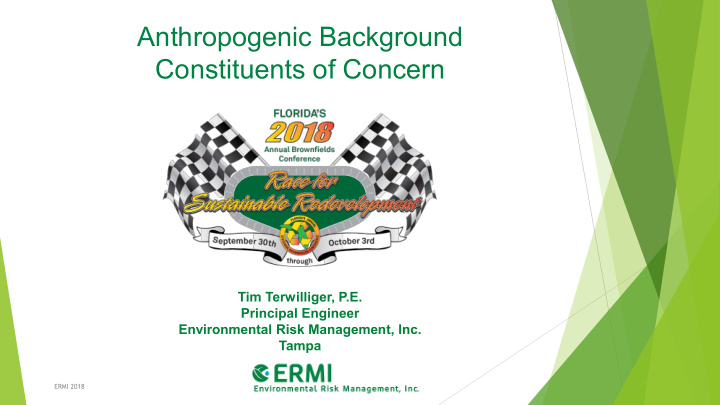



Anthropogenic Background Constituents of Concern Tim Terwilliger, P.E. Principal Engineer Environmental Risk Management, Inc. Tampa ERMI 2018
Acknowledgements Florida Brownfields Association Sub-Technical Committee: • Mike Fisher, SCS Engineers • Leslie Herd, Ramboll Environ • Stephen Hilfiker, Environmental Risk Management, Inc. • Richard Lewis, Lewis Solutions, LLC • Brian Dougherty, Florida Department of Environmental Protection • ERMI 2018
EPA defines 2 different types of background levels of chemicals: 1. Naturally occurring levels, which are ambient concentrations of chemicals present in the environment that have not been influenced by humans 2. Anthropogenic levels, which are concentrations of chemicals that are present in the environment due to human-made, non-site sources (e.g., industry, automobiles) Ref: US EPA Risk Assessment Guidance for Superfund, Volume 1, Human Health Evaluation Manual (Part A). December 1989. EPA/540/1-89/002
Background Constituents of Concern Metals, primarily Arsenic • Polynuclear Aromatic Hydrocarbons (PAHs) • Benzo (a) Pyrene (BaP) • BaP Toxic Equivalents (BaPTE) • Pyrogenic sources (derived from combustion) • vs. Petrogenic sources (derived from petroleum) • ERMI 2018
Natural Background Sources Fires • Natural Oil Formations • Weather Events • ERMI 2018
Anthropogenic Background Sources Industrial combustion processes: • Gasoline, diesel, creosote, coal tar, roofing tar, asphalt, • wood preservation Legal-label application of pesticides, herbicides and fertilizer • Stormwater runoff and dredged sediments • Stack emissions, automobile emissions • Site Development: • Burning waste, fill material, roofing tars, asphalt paving, asphalt • sealants ERMI 2018
References List (partial list) Date Title Notes Florida Studies A guide to the interpretation of metal concentrations in estuarine 1988 sediments. Schropp, S.J. and Windom, H.L., FDER Ecological impact of arsenic and other trace metals from application of 1997 recovered screen material on Florida soils. Scarlatos and Scarlatos 1997 Concentrations and Distributions of Eleven Metals in Florida Soils Ma, et al., University of Florida 1999 Baseline Concentrations of 15 Trace Elements in Florida Surface Soils Ming Chen, et al., University of Florida Assessment of arsenic mobility in the soils of some golf courses in 5-Oct-01 South Florida Florida International University Determining Arsenic Distribution in Urban Soils: A Comparison with 22-May-02 Nonurban Soils Chirenje, T., et al., University of Florida Naturally Occurring Arsenic in the Upper Floridan Aquifer, Southwest 1-Jul-02 Florida University of South Florida U.S. EPA Guidance for Comparing Background and Chemical 9-Sep-02 Concentrations in Soil EPA 8-Jan-03 Arsenic Bioavailability from Florida Soils: Uncertainty Evaluation University of Florida/FDEP 7-Mar-03 Recommendations for Update to Arsenic Soil CTL Computation Contaminated Media Forum 29-Nov-11 Benzo(a)pyrene (BaP) Investigation: Research and Field Analyses Environmental Risk Management, Inc. Guidance for Comparing Background and Site Chemical Concentrations 1-Jan-12 in Soil FDEP 3-Apr-14 Miami-Dade County Anthropogenic Background Study 28-Apr-14 Miami-Dade Presentation to CMF CMF = Contaminated Media Forum 8-Feb-16 Secondary Ground Water Standards at Solid Waste Facilities FDEP 17-Jan-18 U.S. EPA Urban Background Presentation EPA ERMI 2018
Florida DEP Data – Map Direct ERMI 2018
Miami-Dade Study • Ref: Miami-Dade County Background Study Presentation, Wilbur Mayorga, M.S., P.E., Chief, DERM, 2014 ERMI 2018
Hinkley Center for Solid and Hazardous Waste Management Funded by FDEP; hosted by the University of Florida • https://www.hinkleycenter.org/ Background Concentrations of PAHs in Florida Urban Soils • Plan to sample soils in Pensacola, Ocala, West Palm Beach, • and Clay County, starting with Ocala and Clay County ERMI 2018
Understanding the Sources Consider site history • Consider surrounding area history • Fill sources • Flooding events • Lithology • Historical Fires • ERMI 2018
FDEP Background Sampling Guidance “Guidance for Comparing Background and Site Chemical • Concentrations in Soil” Due to be revised soon…check Contaminated Media Forum • Provides guidance for: • Appropriately locating background soil samples • Number of samples needed • Approved statistical analytical methods • ERMI 2018
Case Study Former Fina 6514, Miami, FL • FDEP ID 06/8521982 • 2006 Supplemental Site Assessment Report (SSAR) • Objective: Determine if non-naphthalene PAHs in • the unsaturated zone are a result of petroleum contamination and restricted to the site or widespread throughout the surrounding area. ERMI 2018
0.056 0.108 Former Fina 6514 0.085 0.110 Case Study Former USTs 0.104 and dispensers 0.035 • Detections of BaP that did not match a 0.264 discharge source 0.061 • Off-site concentrations 0.145 higher than on-site 0.062 0.147 0.287 2.150 0.097 #.### BaP Concentration (mg/kg) ERMI 2018
Questions? Tim Terwilliger, P.E. 813-278-7100 Contact Info: tterwilliger@ermi.net
Recommend
More recommend